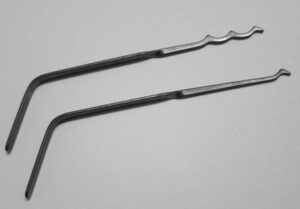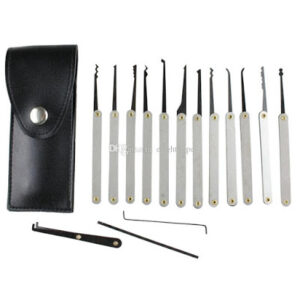Version 1.5
One topic I have not dealt with on this blog so far is that of lock-picking. The reason for this is quite simple. Over the years I have acquired a reasonable body of material on the subject, but, due to a variety of reasons had never actually got around to trying to pick a lock.
Some years ago someone got locked out of their desk and my name was forwarded as “someone who might know how to pick a lock.” (Which sheds some interesting light on how some colleagues view me!) I pointed out I knew how a lock was picked but had never done so. I assembled a useful collection of paperclips, small allen keys and screwdrivers from what I had available. As it turned out, when I experimentally jiggled the lock the entire plug came out in my hand! I reached to the back of the lock with a large screwdriver and turned the latch. Cannot really count that as my first lock picking!
A few weeks back I decided to rectify this. There was a time when if you wanted lock picks you either had to make your own or had to prove you were a professional locksmith. While lock picking is still perceived as being a little dubious it is now more widely recognized that most lock pickers are hobbyists who are more interested in the challenge and skill rather than crime. If a criminal wants something he will usually use more destructive means than picking your lock! Lock picks are now available legally from many internet sites, including well-known outlets such as Amazon and ebay. CAUTION: Check your local laws!
I have seen it claimed that “picking locks makes heroin seem dull!” It is an interesting hobby and there is no feeling quite like popping a lock for the first time. I sometimes work on a padlock during the commercial breaks, varying the picks and tensioners I use or whether the light is on.
I am not going to go into details about to lock picking or the theory behind it in this blog since far more detailed material is freely available elsewhere.
I will cover making your own or improvising lock picks in a future post. If you are new to the hobby I suggest getting some commercially made picks first. Bear in mind that American locks are often larger but shorter than those used in the UK, so some pick designs intended for the former may be cramped in UK locks. Look for items designed for European use or “slim-line” versions.
Hooks and Diamonds
Firstly, some terminology. Basic, conventional picks can be divided into two broad groups: Lifters and rakes. Lifters (also known by other names) manipulate a single pin at a time. (Single pin picking, aka SPP) Lifters include hooks, half-diamonds and half-balls. Terminology for picks can be a little out of wack. A half-diamond will sometimes be called just “diamond” when it is actually a triangle, a “ball” is actually a circle and so on. Just to confuse things further, may rakes are used with a vertical lifting action. Diamonds and balls can be used for both SPP and raking, so are often classed as hybrid picks.


Rakes
Rakes manipulate more than one pin at a time and are used with a variety of actions which include scrubbing, jiggling and ripping. Bear in mind that you can also try these actions with a lifter, often with successful results. There are a number of different forms of rake. 

The snake rake has a sinuous tip. You will see similar forms called “worm rakes”, “S-rakes”, “C-rakes”, “W-rakes”, “serpentine rakes” and similar. Currently I only have one snake-style rake and it seems to work best with a ripping/zipping action.


“City rakes”, “L-rakes”, “ripples”, “waves”, “jags” or “jagged rakes” (also sometimes [also!] called “W-rakes” or “lifters”), look like an irregular sawblade. Personally I did not particularly care for these initially. They seemed like a good way to damage the pins. City rakes should not be used with for horizontal ripping/zipping. They are best used with a vertical lifting or rocking motion. When they do work they tend to work very quickly.

A double-ball pick is also known as a “snowman” or “figure-8” and as you might expect, there is a half-snowman. Ball picks are designed so they do not damage the thin wafers in a wafer lock. Worth having if you expect to deal with filing cabinet or automobile locks. The full-diamond, full-ball and full-snowman are designed for locks that have pins or wafers on either side. With a single-sided pick you can just remove the tool and reorientate the tool. The snowman and his half-brother can be used for raking actions. so like diamonds, are classed as hybrid picks.
Bogotas

The Bogota rake is a relatively new invention and was created by a gentleman called Raimundo. He claims an inspiration was the mountain peaks and gentle valleys surrounding Bogota, Columbia. This type of pick is sometimes called a “jiggler pick”. With a design this good there are inevitably copies and attempts to circumvent copyright. You will see similar designs called “camels”, “pagodas”, “three-humps”, “M-rake”, “batarang”, “w-rake” and similar. Batarangs are actually a separate type that looks similar but is inferior. Bogotas and their ilk lend themselves to a variety of techniques. If jiggling or wiggling does not work, try a lateral wiggle, scrubbing or ripping. The three-hump Bogota is the most consistently performing pick I have, and will sometimes pop a lock open in a few seconds.

Shown is a very clever way of carrying a pair of Bogotas using a safety pin and a spring from a pen. The safety pin itself can be bent into a hook pick if necessary. CAUTION: Check your local laws about carrying lock picks!
This is a good time to introduce my golden lock picking tip. You will generally need much less force than you are using! You will need less pressure on your tension tool than you are using. If scrubbing or ripping you need to only lightly touch the pins rather than remove metal from them. If it is not working, be more gentle! Finesse not force!
Lock picks are usually offered in sets of a dozen or more designs. My personal recommendation would be to ignore these and get a pair of Bogotas. Mine are from Dangerfield.


The handles of the Bogotas are cleverly designed so that one pick can serve as a tension tool while the other is in use. The single-hump can be used as a half-diamond or hook. Picking individual pins needs skill, patience and time. Many locks can simply be raked open, and the three-hump Bogota performs very well for this once you have discovered the correct actions. The rigidity of the Bogotas is useful since some locks will pop with a lateral wiggle, something that may bend or break inferior picks. The polished finish makes manipulation within a lock easier and hides deposited brass.
First Lock Pick Set

I’m well aware most of you will ignore my recommendation above and buy a kit or two. Trying out different tools and methods is part of the fun of a hobby. When I brought my Bogotas, I also brought a very cheap Chinese-made kit. I mainly got it for the practice lock, but the key extractor or pouch alone was probably worth the purchase price. Using these picks makes me appreciate just how good the Bogotas are. Thinner shanks are not necessarily an advantage and black finish reveals how much brass is scraped from the pins. My wishlist includes at least another S-rake. It was, however, satisfying to open my most temperamental lock with a single hook.